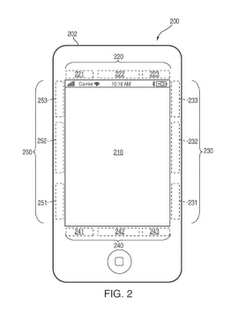But such a screen might be at odds with a new Apple patent application unearthed by Patently Apple. The patent outlines a secondary display embedded within the bezel that would extend what’s happening on the main screen to the surrounding area.
The applications for such a design are broad, from notifications and other indicators to a display area that apps can make use of to extend the user interface. Such features could be handy on a small screen where even given a high-pixel density, total real estate is limited by the casing itself.
The patent description spells this much out:
To assist a user in providing inputs, traditional devices use the display to provide indicators to the user regarding where and how to provide a touch input. For example, a traditional device may display a virtual button on a touch screen to indicate that a user can touch that portion of the screen to provide an input. However, providing such indicators occupies space on the touch screen that could otherwise be used for displaying visual content.
The patent describes this functionality including not just phones, but media players like the iPod, PDAs, laptops, and cameras.
To add to this, the patent says the touch-sensitive area could spill onto this secondary display, effectively opening the device up to a broader array of gestures and types of interactions. The impact on gaming alone could be especially big, with games that make use of onscreen controls choosing to instead go with an off-screen touch pad.
As Patently Apple notes, this is not the first such Apple patent to discuss bringing touch controls to off-screen areas of gadgetry. One in 2006 detailed one for iPods that would use the surrounding area to map playback controls depending on the application in use. This was months ahead of the release of the iPod Touch, which would negate the need for this by making use of a touch screen instead.
More recently, two patents that were actually granted early last year (unlike the one in this story, which remains a pending application), included a bezel that could be set up to control functions such as volume, screen brightness, and navigation.
Another patent depicted adding touch sensitivity to the back of a tablet (such as the iPad) to give users an extra, off-screen area for controlling what was happening onscreen.
As with all other patent-related posts, it’s worth taking these illustrations and ideas with a grain of salt, as they are not guaranteed to become a part of shipping products. Nonetheless, many have, which can make them fascinating.
Related, Imp0rtant, Recent P0sts;
– Apple to Fix Your Blurry iPhone Pictures With Multiple Flash Pulses
F0r M0re UpDaTing:
Be 0ne 0f My New F0ll0wers 0n Twitter,
0ne 0f My New Fan 0n FaceB00k,
And Here Is The Feeds.




